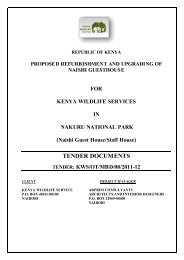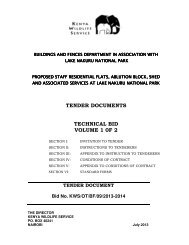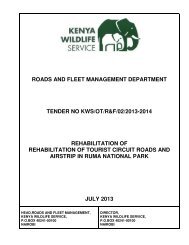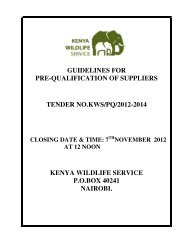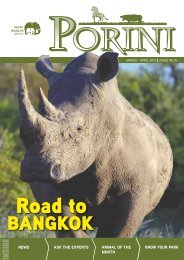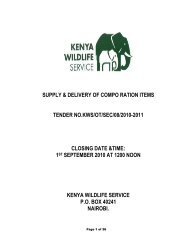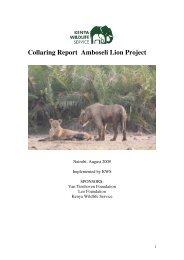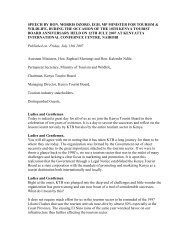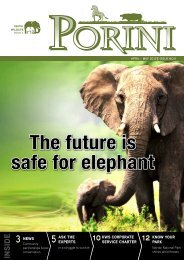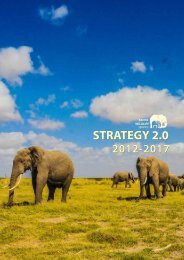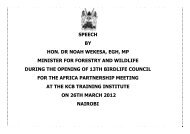Conservation and Management Strategy for the Elephant in Kenya
Conservation and Management Strategy for the Elephant in Kenya
Conservation and Management Strategy for the Elephant in Kenya
Create successful ePaper yourself
Turn your PDF publications into a flip-book with our unique Google optimized e-Paper software.
34 CONSERVATION AND MANAGEMENT STRATEGY FOR THE ELEPHANT IN KENYA<br />
3. <strong>Strategy</strong> vision, goals <strong>and</strong> objectives<br />
3.1 Vision<br />
A secure future <strong>for</strong> elephants<br />
<strong>and</strong> <strong>the</strong>ir habitats, based<br />
on peaceful <strong>and</strong> beneficial<br />
co-existence with people, now<br />
<strong>and</strong> <strong>for</strong> generations yet to come.<br />
3.1.1 Rationale <strong>and</strong> considerations<br />
<strong>Elephant</strong> populations are return<strong>in</strong>g to some areas of <strong>for</strong>mer range, particularly <strong>in</strong> nor<strong>the</strong>rn <strong>Kenya</strong>, as security<br />
improves. Co-existence with humans at low human densities occurred over millennia until modern times <strong>and</strong> <strong>the</strong>re<br />
are still suitable large habitats <strong>in</strong> several areas of <strong>the</strong> country <strong>in</strong>clud<strong>in</strong>g trans-frontier ecosystems which can simulate<br />
<strong>the</strong>se historic conditions: (1) Greater Tsavo ecosystem, <strong>in</strong>clud<strong>in</strong>g Amboseli, with l<strong>in</strong>kages across <strong>the</strong> Tanzania border<br />
<strong>in</strong> <strong>the</strong> West Kilimanjaro bas<strong>in</strong> <strong>and</strong> Mkomazi; (2) Mara ecosystem, l<strong>in</strong>ked to <strong>the</strong> TransMara, Mau complex, Ngurumans<br />
<strong>and</strong> across <strong>the</strong> Tanzania border <strong>in</strong> <strong>the</strong> Serengeti; (3) Around Mount Elgon across <strong>in</strong>to Ug<strong>and</strong>a; (4) Lamu – Tana<br />
ecosystem across <strong>in</strong>to Somalia; (5) Nor<strong>the</strong>rn <strong>Conservation</strong> Area l<strong>in</strong>ked with <strong>the</strong> Laikipa-Samburu ecosystem,<br />
Marsabit, Meru ecosystem l<strong>in</strong>k<strong>in</strong>g <strong>in</strong>to Ethiopia; (6) Nasolot, Rimoi, Kerio Valley, Turkana ecosystem with Sudan.<br />
<strong>Elephant</strong>s can br<strong>in</strong>g significant benefits as: (1) a ‘flagship’ species, a charismatic large mammal, which can be used to<br />
generate <strong>in</strong>terest <strong>in</strong>, <strong>and</strong> f<strong>in</strong>ancial support <strong>for</strong>, <strong>the</strong> conservation of all wildlife <strong>and</strong> <strong>the</strong> communities which share <strong>the</strong>ir<br />
habitats; (2) an ‘umbrella’ species, whose protection provides collateral security <strong>for</strong> overall biodiversity <strong>and</strong> <strong>for</strong> <strong>the</strong><br />
tourist <strong>in</strong>dustry; (3) an ‘architect’ species, capable of modify<strong>in</strong>g habitats to <strong>the</strong> benefit of different plant <strong>and</strong> animal<br />
species on a local or wider scale, depend<strong>in</strong>g on <strong>the</strong> nature <strong>and</strong> extent of <strong>the</strong> impact; <strong>and</strong> (4) a ‘keystone’ species <strong>in</strong><br />
cases where <strong>the</strong>ir presence has a strong <strong>in</strong>fluence on o<strong>the</strong>r species <strong>and</strong> where <strong>the</strong>ir removal is likely to have a<br />
correspond<strong>in</strong>gly strong, even ‘cascad<strong>in</strong>g’ effect on <strong>the</strong> structure <strong>and</strong> function of ecosystems.<br />
The vision <strong>for</strong> elephants <strong>and</strong> people <strong>in</strong> <strong>Kenya</strong> is one of coexistence. To achieve this will require f<strong>in</strong>d<strong>in</strong>g ways <strong>for</strong><br />
people <strong>and</strong> elephants to share <strong>the</strong> l<strong>and</strong>scape, with zones established through participatory plann<strong>in</strong>g at local <strong>and</strong><br />
higher political levels, supported by national legislation. These zones will <strong>in</strong>clude: conservation areas <strong>in</strong>clud<strong>in</strong>g<br />
priority core habitat areas <strong>for</strong> elephants <strong>and</strong> o<strong>the</strong>r wildlife, buffer zones <strong>and</strong> corridors conta<strong>in</strong><strong>in</strong>g mixed l<strong>and</strong> use,<br />
where protection of human <strong>in</strong>terests is concurrently paramount, <strong>and</strong> elephant-free areas <strong>for</strong> human use only.<br />
[ TOP ] Plate 29. A young elephant calf play<strong>in</strong>g - Renaud Fulconis, Awely, Wildlife <strong>and</strong> People



